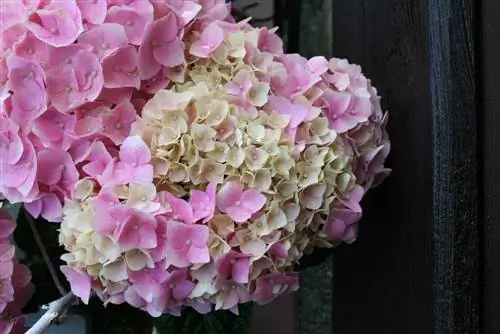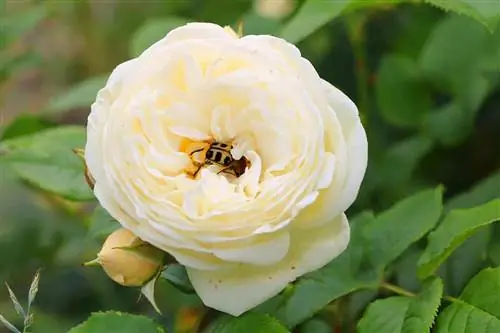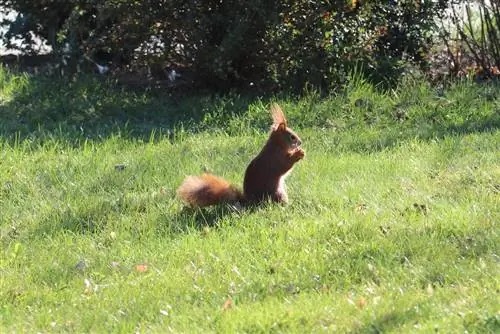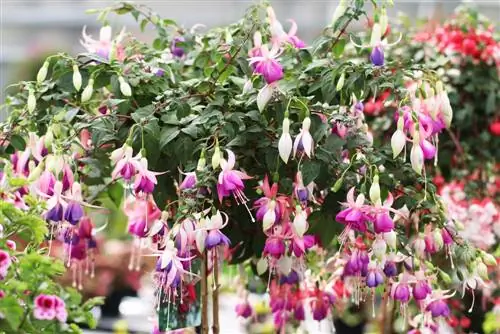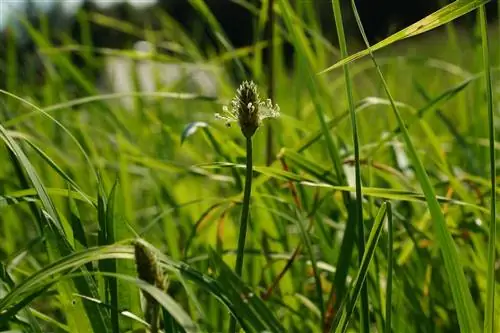- Author admin [email protected].
- Public 2023-12-17 03:39.
- Last modified 2025-06-01 06:48.
Green plants improve the indoor climate, beautify your own four walls, create comfort and promote our inner feeling of well-being. Bamboo and Cyprus grass conjure up exoticism in your own four walls. Roses and orchids create a romantic atmosphere. Lemon and orange trees spread a fresh citrus scent throughout the room, and under a palm tree the holiday beach comes a little closer in your own living room. No wonder that on average every German household is home to a potted plant.
How to green and bloom in your home: Everything about the origin, location and proper care of typical plants in pots.
Potted plants from A to G
Aloe Vera
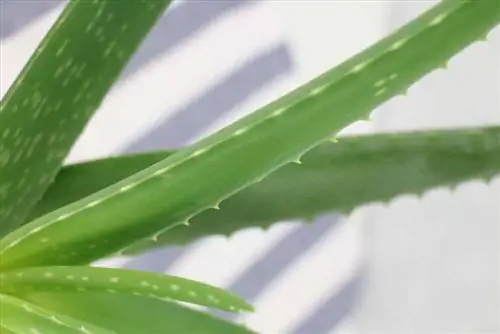
- Origin: South Africa, Arabia
- Leaves: Fleshy and lance-like, with serrated pink edges
- Growth: As a rosette of leaves, circular in all directions.
- Location: Robust plant, tolerates drought and frost.
- Care: Requires little water. Do not pour on the rosette! Water little in winter. Fertilize with cactus fertilizer.
- Note: Robust plant, even in drought and light frost.
- Tip: Well suited for bright, warm rooms.
Azale
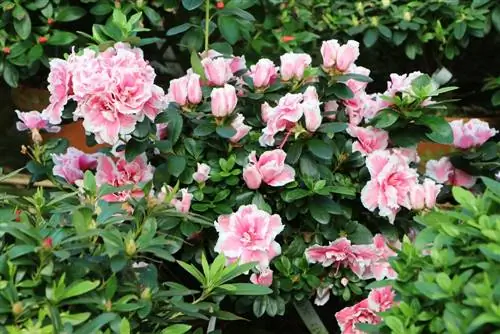
- Origin: Mountain forests East Asia
- Flowers. From white to purple, with double and unfilled flowers.
- Growth: mini plant or flowering standard tree.
- Location: Bright, no direct sun. Airy but not drafty. Partially shaded in summer. Cool from September at 10 to 15 degrees.
- Care: Bales must never dry out. Irrigation water should be adapted to the air temperature.
- Note. Spray a lot.
- Tip: a weekly immersion bath is optimal.
Bamboo
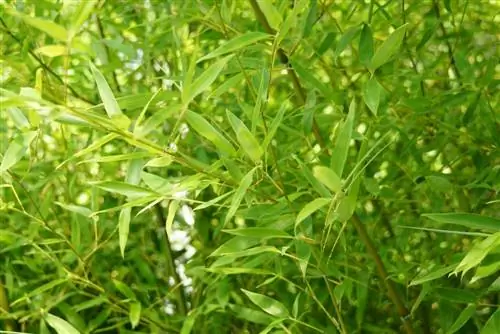
- Origin: Grasslands of China
- Leaves: Evergreen. Short, narrow leaves on thin, strong stems.
- Growth: Low, up to 60 cm high depending on the variety. Culms are dense, initially upright, later overhanging.
- Location: sunny to bright all year round. Can be cooler in winter. Up to 16 degrees.
- Care: Water abundantly all year round. Fertilize every 2 weeks in summer and every 6 weeks in winter.
- Note: can be offered to cats instead of cat grass.
- Tip: Perfect for Asian living style.
Bromeliad
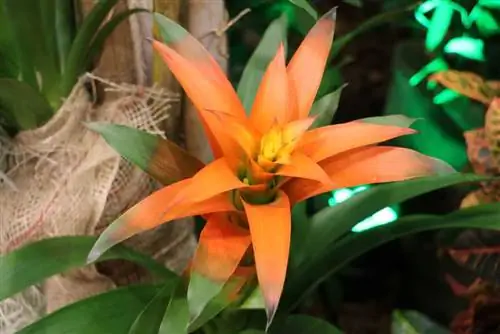
- Origin. Tropics South America
- Flowers: Cone-shaped with reddish bracts.
- Growth: Spreading leaf rosettes.
- Location: As bright as possible, no blazing sun, warm all year round.
- Care: Keep well moist with low-lime water in summer. Fertilize a little weekly. Limit watering and fertilization in winter.
- Tip: To encourage flowering, you can cover the bromeliad with ripe apples with a foil cover for two weeks.
“Calla” - Zatedeschia
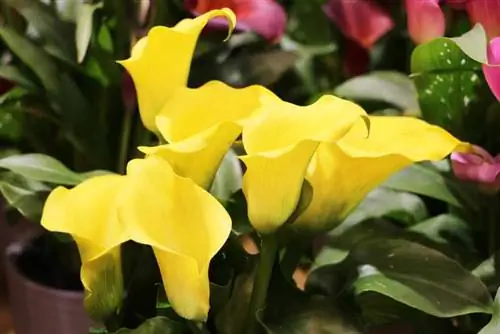
- Origin: South Africa
- Flowers: Yellow, cup-like spadix.
- Growth: intensely colored flowers sprout like small trumpets from the sparsely branched green.
- Location: Sunny to partially shaded. After flowering in May, bright, cool place.
- Care: From December onwards, lots of water and weekly fertilizing with liquid fertilizer. During the rest period from May onwards, very little water supply without fertilizer.
- Note: To promote flowering, place in a warm location with plenty of light in winter.
Chili
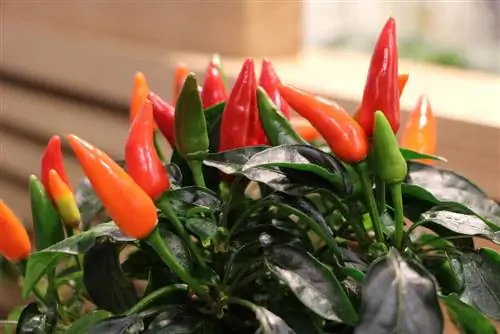
- Origin: Tropics South America
- Flowers: white flowers from June to September. Later bright red pods.
- Growth: Perennial, small bush or woody perennial.
- Location: Sunny.
- Care: Water regularly. Avoid waterlogging. Fertilize moderately.
- Note: Hottest variety: orange habanero. It has three times the amount of hot capsaicin compared to the other varieties.
- Tip: good to use as a spice, for example to spice up sauces.
Fern
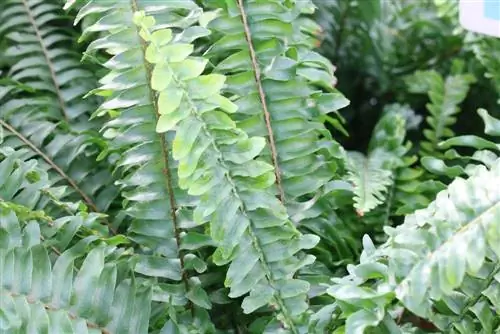
- Origin: tropical rainforests
- Leaves: The sword fern has long, sword-shaped fronds with sickle-shaped feathers.
- Growth: Depending on the variety, spreading or delicate.
- Location: Bright to partially shaded all year round. Not below 18 degrees even in winter. High humidity.
- Care Keep evenly slightly moist. Fertilize once a week in summer.
- Note: are among the oldest plants in earth's history.
- Tip: Only water in tempered water.
Ficus Benjamina
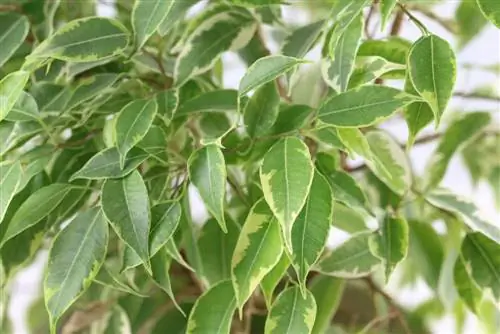
- Origin: Tropics
- Leaves: evergreen, mostly dark green and shiny.
- Growth: tree-shaped or climbing.
- Location: Bright all year round, no full sun.
- Warm in summer, cooler in winter, not below 16 degrees.
- Care: Water moderately in summer, tumble dry in winter when it is cool. Spray more often. Fertilize moderately every 2 weeks in summer and every 4 weeks in winter.
- Note: leaf fall increases in drafts and temperature fluctuations.
- Tip: Ideal for damp rooms, for example bathrooms.
rubber tree
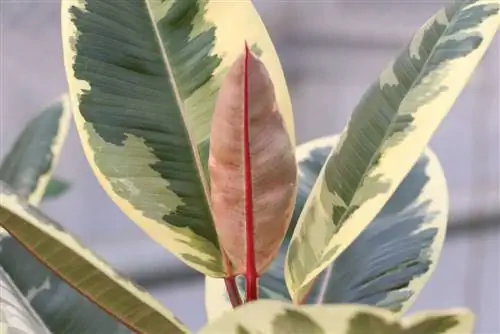
- Origin: Southeast Asia
- Leaves: Large, strong.
- Growth: The leaves sprout on the up to 3 m high, thin trunk.
- Location: Grows well on west, east and even north windows.
- Care: Water evenly with lime-free water. Too much water is just as damaging as too little water. Fertilize every two weeks. Water less in winter, do not fertilize.
- Note: Dust leaves regularly so that the plant can breathe freely.
- Tip: Frequent changes of location lead to leaf fall.
Potted plants from H to Z
hydrangea
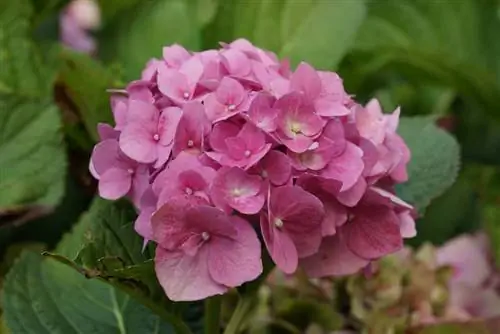
- Origin: mountain forests of Japan
- Flowers: Depending on the variety, hemispherical, ball or plate-shaped in pink, red, white or blue
- Growth: deciduous shrub. Bushy and upright growing.
- Location: Bright, without direct sun. Cool (around 16 degrees), well ventilated. Shady in summer.
- Care: keep moist with low-lime water. Pour into the coaster too. Provide rhododendron fertilizer.
- Tip: Blue-flowering variety turns pink if the substrate is not sufficiently acidic.
Cacti
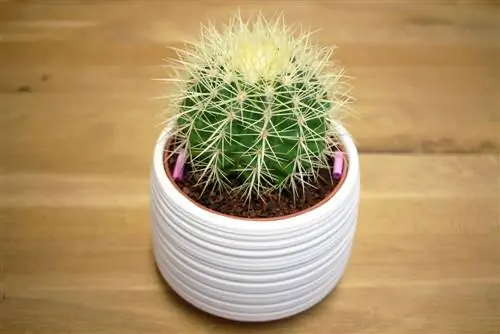
- Origin: dry areas of the world
- Leaves: depending on the variety, flat, wide or spherical ribs.
- Growth: Often colony-forming balls or ribs, densely spiny or hairy.
- Location: Full sun, protect green species with few thorns from the blazing midday sun.
- Care: water sparingly with low-lime water in summer. Fertilize with cactus fertilizer every four weeks.
- Note: Wreath or warty cacti sometimes develop enchanting flowers overnight.
Bugonia
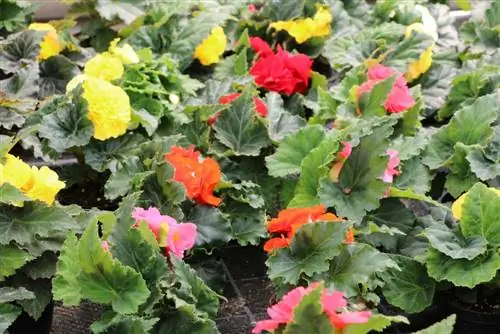
- Origin: South America
- Flowers: From white to pink and orange to shades of red.
- Growth: Bush-like, growing upright or hanging.
- Location: partial shade. In summer also outdoors, protected from the wind. To overwinter, store the tuber in a peat bed in the cellar.
- Care. Water regularly with low-lime water. Fertilize once a week. After flowering in September, watering is reduced until the leaves grow. Start watering in spring.
Linde
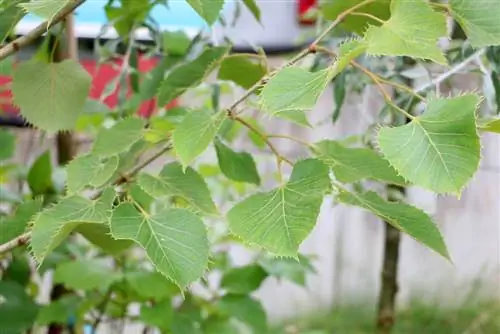
- Origin: light trees Africa
- Leaves. Lime tree: large, rounded to heart-shaped, hairy leaves.
- Growth: Evergreen, as a shrub or tree. With good care, white flowers with yellow stamens appear.
- Location: Bright and airy all year round. Fertilize every 1 - 2 weeks in summer and every 3 - 4 weeks in winter. Spray more often.
- Tip: Can be cut back.
Orange tree
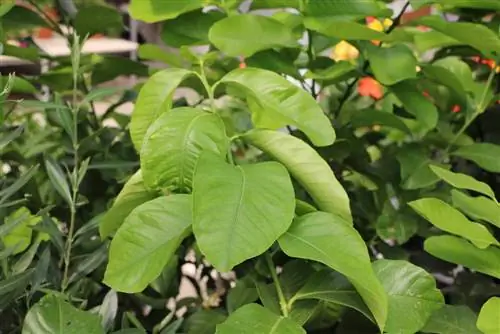
- Origin: Mexico
- Flowers: Seductively orange-smelling white flowers with yellow inflorescences.
- Growth: bush-like growing shrub with lush green leaves.
- Location: sunny and airy. In the sunny months the temperature should be 20 degrees, in winter it should be 5 degrees.
- Care: Water regularly and abundantly. Fertilize once a week in summer, avoid it in winter.
- Note: February is the best time to repot.
Orchid
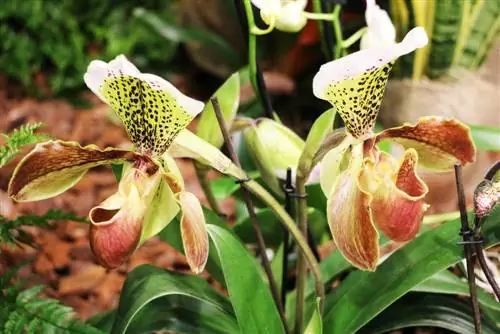
- Origin: Southeast Asia
- Flowers: Medium-sized, delicate inflorescences on a tall stem with leathery leaves.
- Growth: The plant grows epiphytically in nature, i.e. sitting on trees. Their numerous aerial roots indicate this.
- Location: Bright to partially shaded. No direct sun. Ideal: 20 to 25 degrees. White and pink-flowering varieties tolerate cooler temperatures.
- Care: Keep evenly moist. Water more sparingly in winter, but spray. Use orchid fertilizer.
palm tree
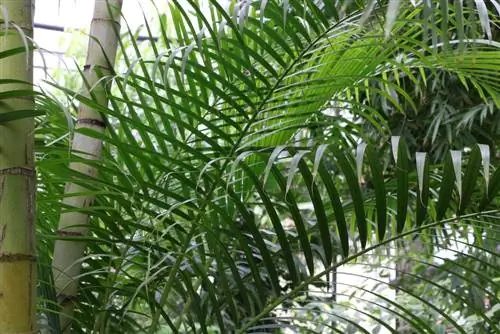
- Origin: Tropics and subtropics
- Leaves: comb-like, pinnate, long fronds, slightly arching.
- Growth: Fronds sit on thin stems that are always grouped together.
- Location: bright, warm all year round, not below 16 degrees even in winter. Young plants not below 20 degrees.
- Care: Always keep moist in summer, water slightly in winter when it is cooler. Fertilize every 3 - 4 weeks in summer and every 6 weeks in winter.
- Tip: Trunk remains as thick as when purchased.
Passionflower
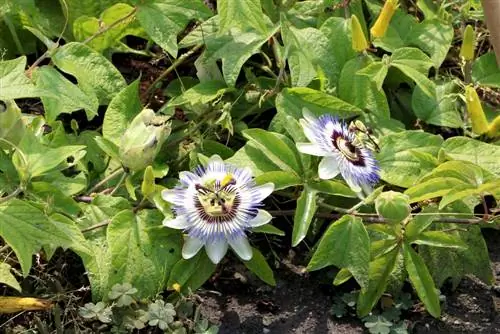
- Origin: South Africa
- Flowers: Up to 10 cm large flower plates made of white sepals and petals with a halo.
- Growth: Perennial climbing plant. Grows up to 2 m high.
- Location: Very bright, but no blazing midday sun. Bright over winter at 6 degrees.
- Care: Water abundantly in summer and fertilize weekly until August. Raise shoots loosely on rods or rings in the pot or on a trellis.
- Tip: Pruning encourages new flower growth.
Roses
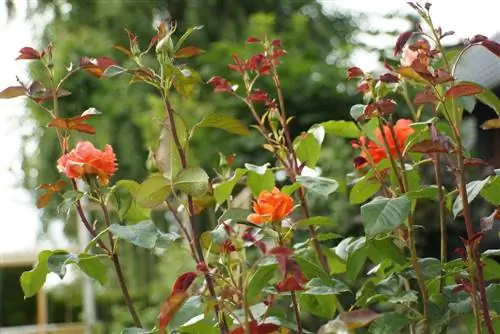
- Origin: Europe
- Flowers: the kissing rose, red flowers. Other species in all colors except blue.
- Growth: Bushy, deciduous dwarf shrub.
- Location: Sunny and airy. Nice on the balcony and terrace in summer. Bright around 5 degrees in winter. To sprout, keep it warmer from February onwards.
- Care: Water regularly during the growth phase. Drier over winter. Fertilize every 14 days until the end of July.
- Tip: remove dead flowers. This strengthens the plant.
Citrus tree
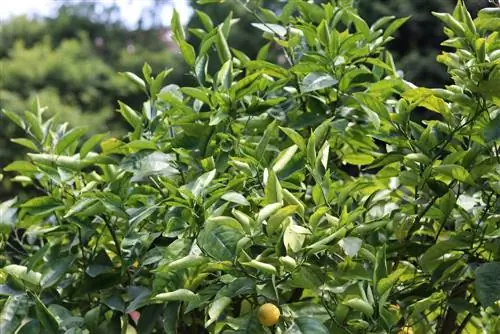
- Origin: Mediterranean region
- Leaves: Long-lasting, with delicate white flowers from which the fruits ripen.
- Growth: Branched shrub or small tree.
- Location: Bright and sunny all year round, warm but airy. Wintering at 15 degrees.
- Care: In summer, water generously with low-lime water, in winter only water sparingly. Fertilize every ten days from February to August.
- Note. If the plant is too warm in winter, it reacts by shedding a lot of leaves.

